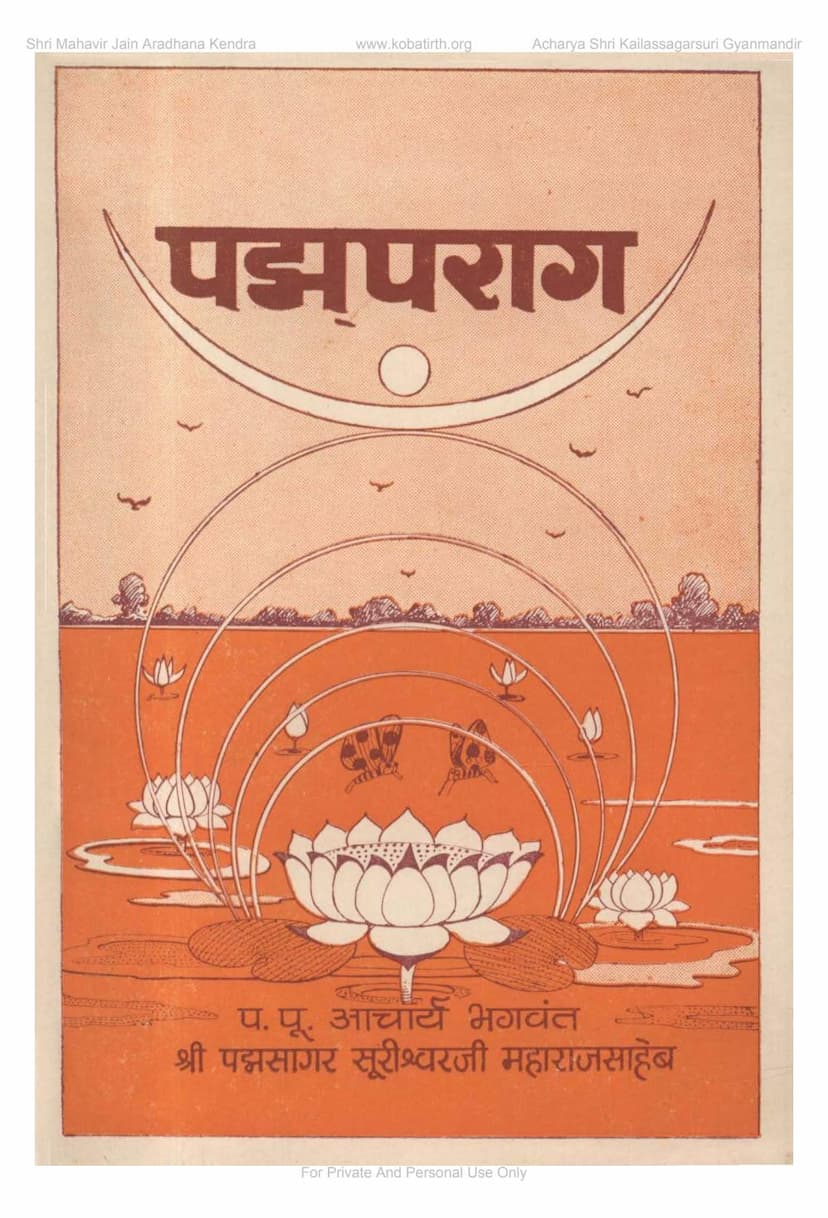Padmaparag
Added to library: September 2, 2025
Loading image...

Summary
This document, titled "Padmaparag," is a compilation of discourses or sermons delivered by Acharya Shri Padmasagarsuri Maharaj Saheb. The publisher is Shantilal Mohanlal Shah.
Here's a summary of the key themes and messages presented in the provided pages:
Core Themes and Messages:
- The Nature of Life and Death: The discourses repeatedly emphasize the impermanence and transient nature of life ("life is perishable, fleeting"). They stress the importance of living with awareness and not being complacent.
- The Role of the Spiritual Guide (Sadhu): Sadhus are portrayed as societal watchmen, like dogs guarding a house. Their role is to awaken the "owner" of the house (the soul) from the slumber of worldly desires and vices, which are likened to thieves.
- True Societal Progress (Mahavir's Vision): Lord Mahavir is presented as a proponent of true societal progress, characterized by equality and upliftment of the downtrodden, rather than bringing down the privileged.
- The Power of Pure Thought and Action: The discourses highlight that listening to discourses with love and devotion purifies the soul, leading to completeness. They emphasize that right thoughts must translate into right actions for true spiritual progress.
- Internal vs. External: A recurring theme is the importance of looking inward rather than seeking happiness externally. The soul is the true dwelling place of the divine, and external pursuits like wealth and worldly comforts are ultimately hollow.
- The Role of Suffering (Dukh): Suffering is paradoxically presented as a benefactor. Great souls like Mahavir and Ramchandra embraced suffering. Suffering is seen as a catalyst for spiritual growth, a means to shed past karmas, and a reminder of the divine.
- Detachment and Renunciation: The text promotes detachment from worldly possessions and desires. It suggests that true freedom comes from shedding burdens and seeking spiritual purity.
- The Importance of Self-Realization: The ultimate goal is to discover the "self within the self" and to strive for spiritual enlightenment. This is achieved through consistent spiritual practice, introspection, and adherence to virtuous conduct.
- The Meaning of Dharma: Dharma is defined as the purity of the inner conscience and the practice of virtues like truth, compassion, and contentment.
- The Danger of Superficiality: The text warns against focusing on outward appearances or rituals without internal transformation. It criticizes the tendency to accumulate wealth or possessions externally while the inner self is impoverished.
- The Power of Faith and Surrender: True spiritual progress requires surrender to the divine, faith in spiritual guidance, and a pure, selfless intention in prayers and actions.
- Overcoming Vices: The discourses identify vices like lust, anger, greed, ego, and attachment as obstacles to spiritual growth and liberation.
Specific Analogies and Examples Used:
- Dog as a Watchman: To illustrate the role of a sadhu in awakening the soul.
- Sieve (Chalni) vs. Sieve (Soop): To differentiate between retaining virtues and discarding vices, or vice versa.
- Doctor's Clinic: To explain why those in critical spiritual need might be given precedence in listening to discourses.
- The Seeking of a Peaceful Place: The analogy of God seeking a truly peaceful place to reside, ultimately finding it within the human heart, emphasizes the importance of inner peace.
- The Weaver: The comparison of a sadhu to a sieve that removes impurities and retains good grain illustrates the process of spiritual refinement.
- The Mulk Bank Analogy: This highlights how external appearances can be deceiving, with valuable contents being stolen while the lock remains intact, symbolizing external religious practices without inner integrity.
- The "Shortcut" Journey: This illustrates that progress comes from consistent effort and action, not just asking for directions.
- The Postman and Karma: The postman delivering a message is analogous to suffering being a messenger of past karma, which should be accepted equanimously.
- Kabir's Blessing: The story of Kabir advising a sad person to become more sad to remember God underscores the spiritual benefit of suffering that leads to remembrance of the divine.
- The Iron Hammer and Anvil: This powerfully illustrates that those who inflict hardship (hammers) are eventually discarded, while those who endure (the anvil) remain steadfast and achieve their purpose.
- The Family and the Business Ledger: This story highlights misplaced priorities, with children more concerned about their father's wealth than his well-being, showing the corrupting influence of materialism.
- Akbar and the Dancing Cat: This anecdote serves as a poignant metaphor for how worldly distractions (like the mouse of greed) can derail spiritual training and commitment.
- Alexander the Great: His inability to take his vast wealth with him in death serves as a stark reminder of the futility of material accumulation.
- Gautam Buddha's Enlightenment: The story of Buddha witnessing old age, sickness, and death and his subsequent renunciation highlights the turning point in his spiritual journey.
- The Iranian King and the Fakir: This story illustrates the difference between asking for worldly possessions from God (seen as begging) versus surrendering to God's will and finding contentment within.
In essence, "Padmaparag" offers a path of spiritual awakening and self-realization through introspection, righteous conduct, acceptance of life's challenges, and unwavering devotion to spiritual principles as taught by Jainism. The discourses aim to purify the mind, cultivate virtuous qualities, and ultimately lead the soul towards liberation.